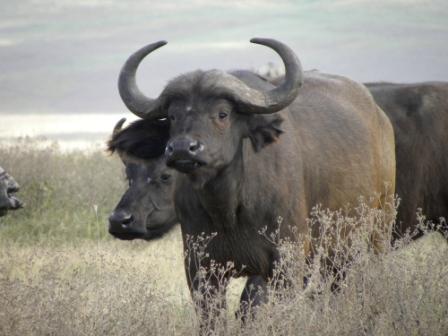CAPE BUFFALO – A Big Five Animal that’s Easy to Spot
By Chitraparna Sinha
A cape buffalo is a hoofed mammal with drooping fringed ears and ridged heavy horns growing straight out from the head or curve downward and then up. These horns have many uses – against predators, jostling for space within the herd and fighting for male dominance.
Normally placid if left alone, a Cape buffalo (Syncerus caffer), or African Cape buffalo, or Savanna buffalo (as it is commonly called) is very unpredictable and can prove to be very dangerous when it is concerned or when it is wounded.
It has made its place in the ‘Top Five’ or the ‘Big Five’ group of animals found in Africa – buffalo, lions, leopards, elephants and rhinoceroses.
There exist in Africa 2 distinct sub-species:
- Savanna (cape) buffalo – larger in size, heavy and cow-like animal. It varies in size and shapes (their horn and color). An adult buffalo is black or dark gray but a young one is reddish brown.
- Forest buffalo – smaller in size and found in west and central Africa. It is red in color throughout its life.
Profile
A brief profile of the Cape buffalo is given below:
- It stands at 39.6 inches to 67.2 inches. Females are shorter.
- It weighs between 935 lb and 2,000 lb.
- It lives between 15 and 25 years.
- It prefers a habitat of grasslands and savannas that has a permanent source of water. It also prefers lowland rain forest.
- It is herbivorous.
- Its gestation period is about 11.5 months.
- It is a target to the lions, leopards, cheetahs, hyenas, crocodiles and humans.
Habitat
Both the sub-species prefer living closer to the water and as such, grasslands, savannas and lowland rain forests are their choice of habitat.
Behavior
A cape buffalo lives in a herd of two hundred or more mainly consisting of females and their young ones as the males prefer leaving the herd when they are about 4. Both hearing and sight are very poor in a cape buffalo but the sense of scent is very developed.
Food Habits
Normally, a cape buffalo would feed at night, its main food being grass.
Size and Lifespan
A cape buffalo stands at 39.6 inches to 67.2 inches (at the shoulder) and are taller than their female counterparts. It weighs about 935 lb to 2,000 lb and can live up to 25 years.
Reproduction
After the birth of a calf, it is seen that the female and the young one have an unusual prolonged and intense relationship. The young one is totally dependent on the mother till about a year, after which it can move about freely.
Predators
A cape buffalo is often a target to the lions, leopards, cheetahs, hyenas, crocodiles and humans. If by chance a herd drifts towards human settlement, the cape buffalos raid the crops, break the fences and help in spreading bovine diseases to the pet livestock.
Threat
Cape buffalo plays a vital role in the ecology of the grasslands. Competition for food sources by goats and cattle have challenged the Cape buffalo but the biggest risk it stands is contracting diseases from these goats and cattle.




